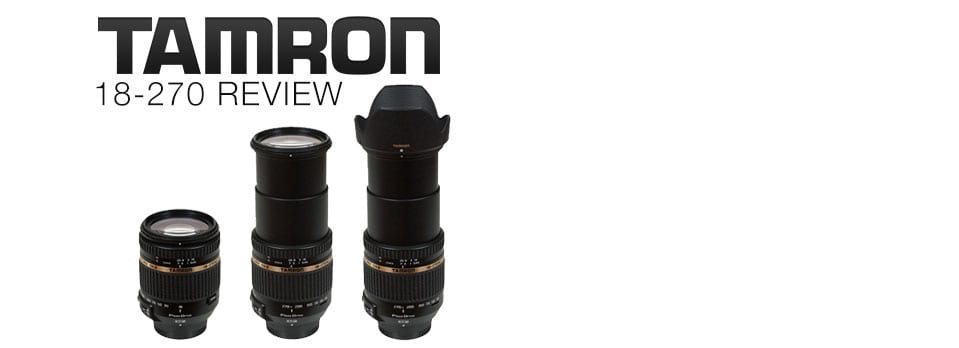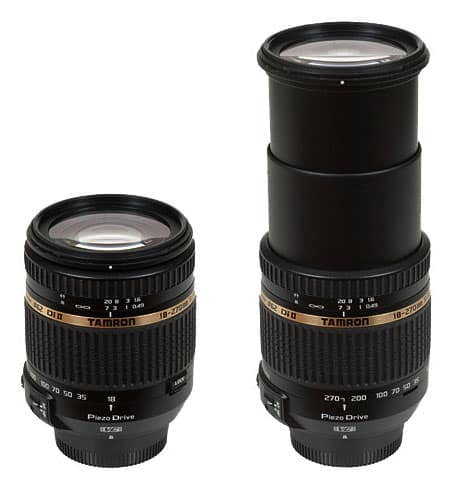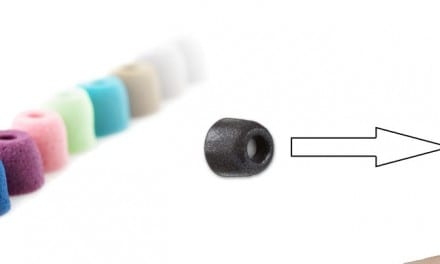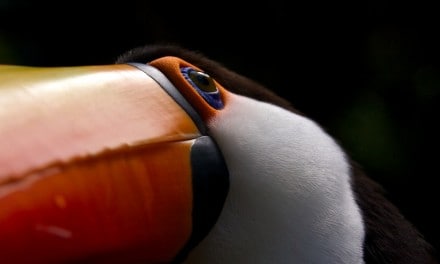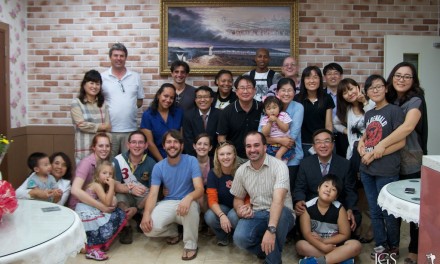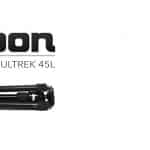Tamron 18-270MM-F3.5-6.3-Di-II-VC-PZD Review
When it came time to finding a lens for our one year around the world trip, I made sure to do my homework. I wanted to be able to take as many different pictures in different situations as possible, while still balancing the cost and weight of the lens. I wanted a versatile lens that would also be reasonably compact and light. When you carry all of your possessions on your back for a year, every square inch of space and ounce of weight is important.
I knew we would possibly be going to Africa, so I wanted to have a zoom lens to handle safaris and animal sightings. Something around at least 300mm zoom would be ideal for capturing elephants, lions, and zebras from a relatively far off distance. From my experience with a previous 300mm lens that did not have stabilization built in, I knew that I would either need a stabilized lens or be mostly limited to having to use a tripod or monopod at the full zoom range. My preference was to to find a lens with stabilization built in but this can usually add significant weight and size to the lens, so this was a concern. I enjoy mostly taking landscape shots, so I also wanted a lens that could zoom out to 18mm or less to capture as much of the view as possible.
Finding The Lens
With these criteria and possible trade offs in mind I started searching the internet for options. First I checked Canon’s lenses but none of them had the zoom range I was looking for and any of their stabilized lenses were usually rather large and heavier than I would have preferred so I moved on. In the end, I searched through a total of four of the top lens manufacturers in the world and was excited to find one lens that met all of my criteria and more and is actually the worlds smallest and lightest zoom lens in its class! In addition to this, it was priced in a reasonable range for such versatility and far cheaper than anything similar by most of the other manufacturers.
The lens I am talking about is the TamronThe Company who makes this lens. They are among the top four manufacturers in the world. 18-270mmThis is the zoom range in millimeters. For point and shoot users, this is equivalent o a 15X optical zoom and is almost unheard of for D-SLR Cameras F/3.5-6.3This is the lowest f-stop range of this lens. It is a measurement of how much light the lens can let in. More on f-stop later. Di IIThis is Tamron's indication that this lens is made for most consumer DSLRs and engineered for optimal image quality. VCStands for Vibration Compensation - the technology that is built into this lens to help keep images sharp. This is great for longer exposures, or highly zoomed in images as your hand can shake a little and would otherwise cause some blur. PZDStands for Piezo Drive - Tamron's breakthrough technology that allows for faster and quieter precision autofocus while also reducing the size and weight from the previous version of this lens.. To help myself and others out, I have added some tooltips to explain what all those letters and numbers mean for humans;-) Just hover your mouse over the word you want to know about and a pop-up will give you some more information about it.
Design
I am no scientist or optical expert, but, by judging from the size, shape and weight of other lenses with similar and even less capabilities, I think Tamron has made more than a few technological breakthroughs with this lens. This is actually the second version of an 18-270mm lens that Tamron has made. Their first one was also amazingly small and light, but this one took everything a step further and they were able to achieve an incredible 24% reduction in length and a 18% reduction in weight. Check out the image below for what that looks like visually. Very impressive in my opinion.
A 24% reduction in length and 18% reduction in weight from previous version

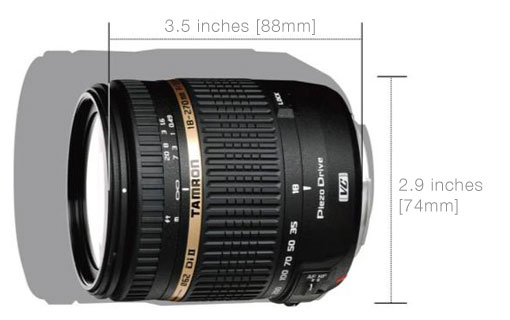
Having an Industrial Design background, I am very picky about the way things look, feel and operate. That being said, I have been very impressed with this lens given its price range and versatility.
Size & Weight
As stated earlier, this is the the world’s lightest and smallest lens in its range, so it kind of speaks for itself on that. There is no competition for this lens from a size, weight and versatility perspective. It measures 3.8″ from the tip of the lens to the base of the mount and probably a little closer to 4″ long with the lens cap and mount protector on it. It is just under 3″ in diameter and fits nicely into even my very small draw-string type daypack with many other supplies. Overall, the lens is about the size of my fist, which, for a 15X zoom SLR lens is amazing. One of the fun things about this lens due to it’s compact size is the surprised comments I get from people when they see it go from 18mm to fully zoomed. This is because as it looks about the size or smaller than most 18-50mm lenses that come standard on most DSLR Cameras when zoomed out, but is about three times longer than any of them when zoomed in. check out the picture below to see what I am talking about.
The lens weighs right under 1 pound and when handling it, feels a little on the heavy side for its size, due to its compactness. However, when fully extended the weight seems to jump to the other side and feels almost too light, but it is, in fact, well balanced. Too light from an old school weight = performance perspective, but the lighter the better from a new school travel photographer perspective.
“Illegal” Activities
One situation where this lens really helped out was when visiting the DMZ or Demilitarized Zone on the border of North and South Korea. They have a rule that no lenses with a zoom range of greater than 90mm is allowed. Normally any lens with a zoom range is rather easy to spot as it would either be a lot lot longer, or a lot wider diameter (or both) than this Tamron lens, but this lens is deceptively small. Because of this, my lens was not spotted or inspected closely and I was able to get this shot of a north Korean soldier from across the border line.
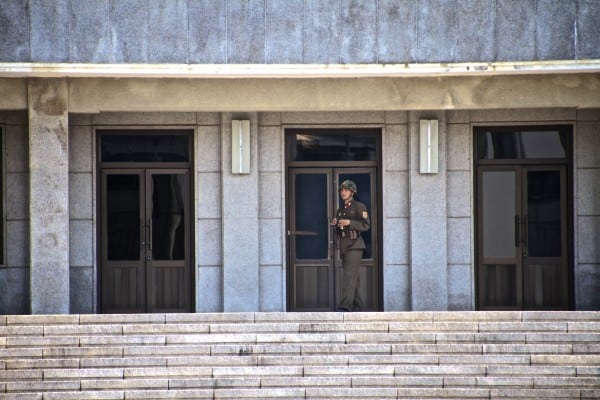
Taken using the Tamron 18-270MM-F3.5-6.3-Di-II-VC-PZD fully zoomed at 270mm.Click to view larger, or see original image here.
To give you a better idea of the incredible zoom range of this lens, here is a picture take from the same location at 18mm. The guard from the picture above is just barely visible next to the centered door of the building in the background.
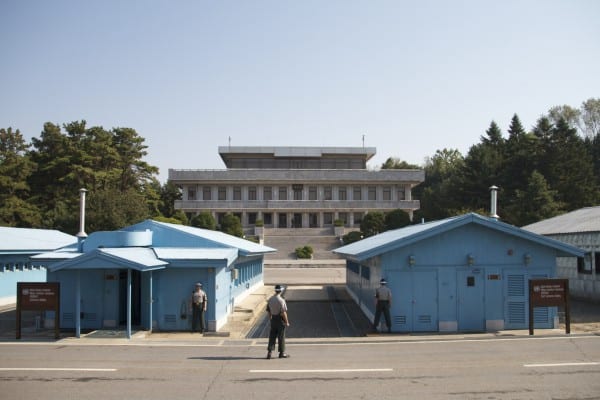
Taken using the Tamron 18-270MM-F3.5-6.3-Di-II-VC-PZD fully zoomed out to 18mm.Click to view larger, or see original image here
Build
The lens feels very solid and reasonably durable but is also very small and light for its capabilities, which shows in some of the build techniques as a lot of the parts of the lens are made of a high quality plastic in where other, more expensive lens might use metal. I see this as more of an advantage than a disadvantage because of the focus of this lens. Tamron set out to make the smallest, lightest and one of the most versatile lenses in the world and they could not have done that with heavier metal parts or maintained the reasonable price with less strong, but more expensive aluminum. I can tell from holding the lens and using it that this is a quality made lens and that, while made out of plastic, it will withstand reasonable abuse and has for the past 9 months of our trip so far. The only semi complaint I would have about the build quality is that he lens does seem to creep
Switches
There are three total switches on the lens including an Autofocus /Manual Focus, Vibration On/Off and a lens lock switch. All the switches feel pretty solid with the exception of the lens lock button, but it it the one that is used the most and having it be easier to moves actually makes more sense, so I wouldn’t call it a disadvantage so much, just hope it doesn’t break as it does feel less than solid overall. That being said, no issue to date that I have experienced.
Features
The biggest feature of this lens by far, is its combined size, weight and zoom range. Add to all that, the virtually silent vibration control and this is a very full featured lens.
Negatives
What? Did you think this lens was all cherries and ice cream? While this lens does have an impressive feature set and amazing versatility, there are a few trade offs that go against a possible purchase.
F-Stop
In the tooltips at the beginning I said I would touch back on f-stop later. Well now is the time. f-stop is a measurement for the amount of light a lens lets in to the camera. Below is an example of some different f-stop settings.

As you can see, the lower the f-stop, the bigger circle of light that is let into the camera. The benefits of being able to use a low f-stop like f/2 or f/1.8 as seen below this are twofold:
- First, because the lens is letting in more light, you are able to take more blur free images even in low light, or when zoomed in really far. If you have ever seen sports photographers with their lenses ten times bigger than their cameras, that is because they are zooming in really far, but still want the maximum amount of light available so they can get a blur-free photo of the winning touchdown or slam-dunk, etc.
- The second advantage of being able to use a very low f-stop is that it allows you create what is called a “shallow depth of field” in your images. Maybe you’ve seen a picture of a flower, or a professional outdoor portrait where the petals or the person’s face is in sharp focus, but the entire background of leaves, grass, trees, etc. is blurry and out of focus looking. This makes the subject of the photo stand out even more and the background visually seem to fade away and become unimportant further emphasizing the subject. This is called depth of field and the lower the aperture, the smaller the depth of field which, in turn make it easier to blur out the background and/or foreground and guide the viewer’s eye to the main subject of the image. Check out the slider below for a more visual way to understand depth of field.
LEFT = F5 | RIGHT = F32
[beforeafter] 
 [/beforeafter]
[/beforeafter]
I share all this to say that an f-stop of 3.5 is OK for low light and/or a shallow depth of field, but by no means ideal, and the minimum aperture of 6.3 is pretty difficult to use for blur free photos in all but the brightest of days and does not allow for a shallow depth of field for the most part. There are work-arounds to both of these issues such as using a tripod, a flash and placing the subject much farther away from its background, but these are more advanced techniques and not usually well known or utilized by the person this lens would generally be marketed to.
The other issue besides the f-stop for this lens that I ave found is that throughout the zoom range and especially at the 270mm range, pictures are not very in focus and sharp to a trained eye. Additionally there is some heavy vignetting at certain zoom ranges, but both of these issues should be considered while also taking into account the incredible zoom range of this lens is somewhat of a marvel in itself.
Conclusion
Overall I would highly recommend this lens to anyone who is a beginner to intermediate photographer looking for a versatile all-in-one lens for less than $1000 that is small and light. I say beginner to intermediate not because you can’t take professional pictures with this lens, but because I think it would be harder for a professional to set himself apart consistently due to the limitations of this lens. I knew the limitations to this lens going into it and have been more than pleased with what it can do and the lack of a burden it puts on my back while carrying and the lack of dents caused to my wallet when purchasing it. If you are looking for one great zoom lens that should be able to capture about 90% of the pictures you would want to take of cities, landscapes and people both close up and from a distance in bright light, then this is the lens for you!
Big thanks to Tamron USA for their support and partnership of our photography and for supplying the lens reviewed.
For more information about Tamron and the lenses we use, check out our sponsors page here.
Full Specs
*values given for Nikon AF cameras
**Length is the distance between the mount face and the tip of the lens. Entire length is the distance between the tip of the lens and the tip of the protrusion.
***The Sony mount does not include the VC image stabilization functionality, as the body of the Sony digital SLR camera includes image stabilization functionality.
Before & After demo images from flagstaffotos.com.au

